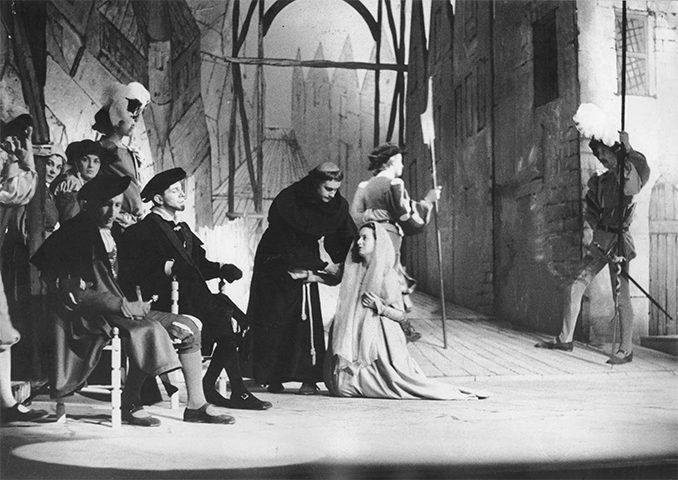Debut: Genoa, Sala Eleonora Duse, 22 December 1957
| Translation | Luigi Squarzina |
| Direction | Luigi Squarzina |
| Assistant director | Renzo Frusca |
| Set | Gianni Polidori |
| Costume | Maria De Matteis |
| Music | Angelo Musco |
| Production | Teatro Stabile di Genova |
Characters and performers
| Vincenzo, the duke | Renzo Ricci |
| Angelo, the vicar | Enrico Maria Salerno |
| Escalo, an elder | Gino Bardellini |
| Claudio, a young gentleman | Osvaldo Ruggieri |
| Lucio, a fantastic | Franco Parenti |
| First gentleman | Carlo Delmi |
| Second gentleman | Gino Viziano |
| Third gentleman | Mario Gallo |
| Varrio | Ugo Salvadori |
| The bargello | Gastone Moschin |
| Friar Peter | Gianfranco Ombuen |
| Elbow, city guard | Gianni Pincherle |
| Foam | Luigi Carubbi |
| Pompey, servant of madonna Strafotta | Renzo Palmer |
| The Executioner | Carlo Delmi |
| Bernardino, unrepentant convict | Pietro Tordi |
| A scribe | Libero Ricci |
| First guard | Mario Gallo |
| Second guard | Enrico De Marchi |
| Isabella, Claudio's sister | Valeria Valeri |
| Mariana, Angelo's girlfriend | Bianca Galvan |
| Giulietta, Claudio's lover | Tiziana Casetti |
| Francesca, nun | Simona Sorlisi |
| Madonna Strafotta, pimp | Ada Vaschetti |
| A maid | Milly Mascaro |
| First courtesan | Franca Lumachi |
| Second courtesan | Santina Fabbri |
Squarzina staged three editions of this play: in 1957, 1976 and 1980, following different readings. Since the very first edition, he has curated its translation, considered exquisite and theatrically valid, modern and brilliant.
In the first edition Squarzina reads in the Shakespearian comedy the hypocrisy of censorship, which was in force at the time, with a light and pleasant direction, adhering to the spirit of drama, sober and clear, organic and elegant, paying a great homage to culture.
In the second edition he situated the production in its cultural and historical dimension, making Shakespeare our contemporary: indeed, he saw in it “the themes of the ambiguity of religious, political, and judiciary power; of the corrupted and ungovernable city that must still be governed; of order and disorder, inextricably entangled”.
In order to determine the comedy’s cultural and political motivations and its theatrical connotations in the field of Elizabethan theatre, and to understand the possible connections with our problems of the 1970s, he furnishes the production with university lectures, dedicating to Shakespeare a monographic course in 1976-77. Therefore, Squarzina accompanies the successful encore performances of Measure for Measure in Italian theatres with the essay “Le strutture del teatro elisabettiano-giacobeo” (“The structures of Elizabethan-Jacobean theatre”, 1978).
The production of the second edition and the observations developed through the monographic course and in the essay can be read as references to our national history in the final quarter of the last century. And this is the essential merit of Squarzina’s innovative reading of a great classic: the manifold abuse of power, the hypocrisy of virtue and purity, the unmaking of values and the confusion of moral languages, the iniquity disguised as justice.
The production, even though clearly pointing out the connections with the political, social and cultural history of England, is projected towards our time, so much so that “Squarzina’s Shakespeare becomes contemporary... through a reading as humble as it is piercing, made, though, with the vigilant conscience of a modern man”, a deeply examined and frontal reading of modernity, all civil (thus political, but not politicised).
The third edition came on the heels of the essay “Brecht e gli elisabettiani” [“Brecht and the Elizabethans”], 1979, wherein he introduced the comparison between Brecht’s “Round Heads and Pointed Heads” and the Shakespearian text, the primary source for Brecht’s play, into his design for the contemporary production, which was not staged because of copyright issues. In this edition, “considering the text’s mysterious quality as a seismograph, the three years that have shocked us between ’76 and ’79 could not but be influential on the main characters’ ideological convolutions and on their interplay... years on top of which power managed once again to return shamelessly to the fore, aided by that very ‘dread’ that in fact reinforced the domination that it claimed to be trying to undermine”.
Shakespeare, once again, is our contemporary.
Si ringrazia il teatro Nazionale di Genova per la concessione dell’utilizzo del materiale fotografico.

